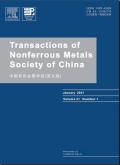不同铁含量的电子束增材制备Ti−1Al−8V−5Fe合金的显微组织和力学性能
IF 4.7
1区 材料科学
Q1 METALLURGY & METALLURGICAL ENGINEERING
Transactions of Nonferrous Metals Society of China
Pub Date : 2025-05-01
DOI:10.1016/S1003-6326(25)66763-X
引用次数: 0
摘要
采用电子束粉末床熔炼(EB-PBF)制备了不同铁含量的Ti- 1Al - 8V - 5Fe (Ti-185)合金,并对其显微组织和力学性能进行了研究。结果表明:当Fe粉含量从4.56 wt.%增加到5.98 wt.%(在规范范围内)时,通过EB-PBF可将打印合金中的粗柱状-β晶粒转变为细等轴晶粒((54.2±32.4)μm);然而,由于随后的原位沉淀,沿各等轴晶界(GB)普遍存在微米厚的低溶质弱α-相。这大大降低了Ti-185的拉伸变形能,从6.2×107 J/m3(柱状晶)到4.8×107 J/m3(等轴晶),尽管强度略有增加。断裂特征表明,弱GB α-相是裂纹的主要起裂部位和扩展路径。本文章由计算机程序翻译,如有差异,请以英文原文为准。
Microstructure and mechanical properties of electron beam additively manufactured Ti−1Al−8V−5Fe alloy with different iron contents
Ti−1Al−8V−5Fe (Ti-185) alloy with different iron contents was additively manufactured by electron beam powder bed fusion (EB-PBF), and its microstructure and mechanical properties were investigated. The results show that increasing the Fe powder content from 4.56 wt.% to 5.98 wt.% (within the specification range) converted coarse columnar prior-β grains in as-printed alloy into fine equiaxed ones ((54.2±32.4) μm) by EB-PBF. However, due to subsequent in-situ precipitation, a micron-thick low-solute weak α-phase became prevalent along each equiaxed grain boundary (GB). This drastically decreased the tensile deformation energy of Ti-185 from 6.2×107 J/m3 (columnar grains) to 4.8×107 J/m3 (equiaxed grains), despite a mild increase in strength. Fracture characteristics unveiled that the weak GB α-phase is the main crack initiation site and propagation path.
求助全文
通过发布文献求助,成功后即可免费获取论文全文。
去求助
来源期刊
CiteScore
7.40
自引率
17.80%
发文量
8456
审稿时长
3.6 months
期刊介绍:
The Transactions of Nonferrous Metals Society of China (Trans. Nonferrous Met. Soc. China), founded in 1991 and sponsored by The Nonferrous Metals Society of China, is published monthly now and mainly contains reports of original research which reflect the new progresses in the field of nonferrous metals science and technology, including mineral processing, extraction metallurgy, metallic materials and heat treatments, metal working, physical metallurgy, powder metallurgy, with the emphasis on fundamental science. It is the unique preeminent publication in English for scientists, engineers, under/post-graduates on the field of nonferrous metals industry. This journal is covered by many famous abstract/index systems and databases such as SCI Expanded, Ei Compendex Plus, INSPEC, CA, METADEX, AJ and JICST.

 求助内容:
求助内容: 应助结果提醒方式:
应助结果提醒方式:


